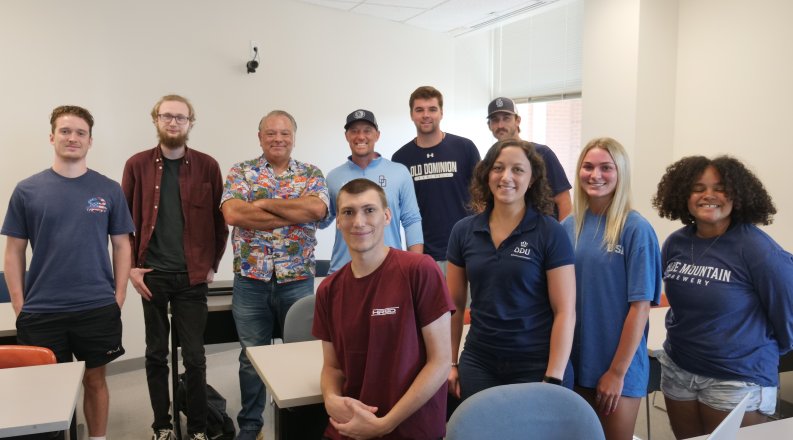By Tiffany Whitfield
To expand undergraduate research initiatives at Old Dominion University, a new collaboration between mathematicians and athletes has been forged. Students in MATH 494 (Entrepreneurship in Mathematics) are working alongside ODU’s baseball players in a uniquely designed course to build a pipeline between data and America’s oldest sport.
For the fall 2024 semester, Mathematics and Statistics Master Lecturer and Chief Departmental Advisor Robert “Bob” Strozak and Senior Lecturer Katie Rafferty have teamed up with ODU's baseball pitching coach, Mike Marron, to create a new collaborative undergraduate research course. The course offers students an opportunity to apply their knowledge of mathematics and analytical skills to the development of a new product, business, nonprofit program or other initiative. In this case, they’re helping Monarch baseball players develop and grow through data.
“This is the brainchild of Nick Murray who was our director of player development (the) last two years, just prior to this year,” Marron said. “He actually got a job with the Boston Red Sox as the rehab pitching coordinator.”
Prior to his career move to Major League Baseball, Murray met with Strozak to get the ball rolling on working with the math department to provide data analytics for ODU’s baseball team.
In the course, mathematics and statistics students are learning baseball in real time and how to apply their knowledge to data analytics.
“The students are learning the fundamentals of baseball statistics and analyses, and how to present their results using the R programming language,” Strozak said.
Velocity, runners on base, number of pitches inside of the strike zone and more can all be calculated mathematically. Mathematical terms like XYZ coordinates, YXZ axis can be directly applied to the Trackman© system, which is an app to help track each pitch and how its data is used to support baseball analytics.
“Over the last five to 10 years, there’s a ton of information that’s out there that have always been in existence, but we are finally starting to have some technology that allows us to objectively measure it and use it,” Marron said.
Statistics and analytics have existed since the beginning of the game from batting average to earned run average (ERA), but recently the amount of data and analytical tools available have increased dramatically.
“Seeing and using data to help ODU baseball players has been really valuable and beneficial from a development standpoint,” Marron said.
Also, Marron posed these questions to the mathematicians in the course, “What can we use that’s out their informationally to help our guys learn the game better, or learn who they are as baseball players, and what can we do to get them in a better path from a development standpoint?”
The collaborative work in having math majors drill down into the data analytics of each individual ODU baseball player will create innovation and problem-solving skills.
“The course will prepare the students to work for ODU's baseball team (should they choose to) in the spring,” Strozak said. “The team will visit the class periodically, and we will visit the baseball field on occasion.”
All students in the class will create ePortfolios containing their class projects which will be viewed by ODU's baseball team. “Hopefully, the ePortfolios can be used outside of the University as students pursue employment opportunities,” Strozak said.
“There are business opportunities out in the game, in professional sports, that never existed before to this level,” Marron said. “From an analytics viewpoint, there’s a ton of opportunities that we get to explore through this course.”
For each student, the final project of the course will be a set of reports requested by the baseball team. After completion of MATH 494, the students will be prepared to become members of ODU’s baseball data analytics team and can start working with the baseball team the following spring.
“Our goal is to offer MATH 494 every fall to continuously provide a pipeline of undergraduate researchers to provide analytics to the ODU baseball team,” Strozak said. “We are very hopeful that this will be a long-term incubator of undergraduate research for the Mathematics Department.”
In addition, this course could be a game changer for graduate students in the Department of Mathematics and Statistics. “We foresee an expansion into our graduate program where our experts in big data analytics will work with graduate students to develop new (and possibly proprietary) baseball analytics,” Strozak said.



